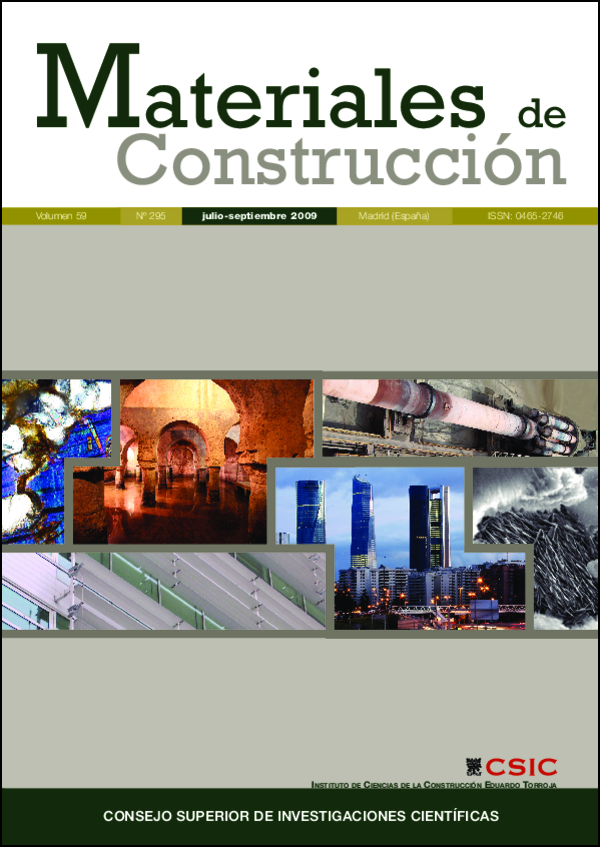Design and performance of masonry mortars made with recycled concrete aggregates
DOI:
https://doi.org/10.3989/mc.2009.44207Keywords:
recycled-concrete aggregate, masonry mortar, mechanical performance, durabilityAbstract
The present paper discusses the technical feasibility ofusing the fine fraction of recycled aggregate fromconcrete rubble to manufacture cement mortar andpossible conditions.
An initial study of the chemical and physical-mechanicalcharacteristics of fines recycled from selected concreteshowed that their high absorptivity and high sulfatecontent compared to natural limestone sands were thelimiting factors to their in masonry mortars.
As in the caseof structural concrete, a blend of recycled and naturalaggregate would appear to be suitable for masonrymortars.A study of the mix proportions and characteristics ofmortars made with recycled concrete aggregate showedthat up to 25% recycled aggregate can be used incement-based masonry mortars with no significant declinein performance and no new admixtures or higher cementcontent requires.
Downloads
References
(1) Poon, C. S.; Kou, S. C.; Lam, L.: “Use of recycled aggregates in molded concrete bricks and blocks”, Construction and Building Materials, 16 (2002), pp. 281-289. doi:10.1016/S0950-0618(02)00019-3
(2) Monografía M-11-ACHE: “Utilización de árido reciclado para la fabricación de hormigón estructural”, p. 15, ACHE, 2006.
(3) Sánchez de Juan, M.; Alaejos, P.: “Influence of recycled aggregate quality on concrete properties”, Proceedings (PRO 40) of International RILEM, conference on the use of recycled materials in building and structures, vol. 1 (2004), pp. 545-553.
(4) Winkler, A.; Müeller, A.: “Recycling of fine processed building rubble materials”, Use of Recycled Concrete Aggregate, pp. 157-168, Thomas Telford Publishing, London, 1998.
(5) Sánchez de Rojas, M. I.; Marín, F. P.; Frías, M. and Rivera, J.: “Viability of utilization of waste from ceramic products in precast concretes”, Mater. Construcc., 51 (263-264) (2001), pp. 149-161.
(6) Mesbah, H. A.; Buyle-Bodin, F.: “Efficiency of polypropylene and metallic fibres on control of shrinkage and cracking of recycled aggregate mortars”, Construction and Building Materials, 13 (1999), pp. 439-447. doi:10.1016/S0950-0618(99)00047-1
(7) Corinaldesi, L. F. R.; Giuggiolini, M.; Moriconi, G.: “Use of rubble from building demolition in mortars”, Waste Management, 22 (2002), pp. 893-899. doi:10.1016/S0956-053X(02)00087-9 PMid:12423051
(8) Miranda, L. F. R.; Selmo, S. M. S.: “Construction and demolition waste variability and its influence on mansory and plastering mortars properties”, Proceedings of WASCON 2003 (2003), pp. 241-250.
(9) Miranda, L. F. R.; Selmo, S. M. S.: “CDW recycled aggregate renderings: Part I – Analysis of the effect of materials finer than 75 μm on mortar properties”, Construction and Building Materials, 20 (2006), pp. 615-624. doi:10.1016/j.conbuildmat.2005.02.025
(10) Miranda, L. F. R.; Selmo, S. M. S.: “CDW recycled aggregate renderings: Part II – Analysis of the effect of materials finer than 75 μm under accelerated aging performance”, Construction and Building Materials, 20 (2006), pp. 625-633. doi:10.1016/j.conbuildmat.2005.02.026
(11) UNE-EN 1313: Áridos para morteros, 2003.
(12) UNE EN 998-2: Especificaciones de los morteros para albañilería. Parte 2: morteros para albañilería, 2004.
(13) Rolón Aguilar, J. C.; Mendoza, D. N.; Huete Fuentes, R.; Blandón González, B.; Terán Gilmore, A.: “Characterization of concrete made with recycled agregate from concrete demolition waste ”, Mater. Construcc., 57 (2007), pp. 5-15.doi:10.3989/mc.2007.v57.i288.61
Downloads
Published
How to Cite
Issue
Section
License
Copyright (c) 2009 Consejo Superior de Investigaciones Científicas (CSIC)

This work is licensed under a Creative Commons Attribution 4.0 International License.
© CSIC. Manuscripts published in both the print and online versions of this journal are the property of the Consejo Superior de Investigaciones Científicas, and quoting this source is a requirement for any partial or full reproduction.
All contents of this electronic edition, except where otherwise noted, are distributed under a Creative Commons Attribution 4.0 International (CC BY 4.0) licence. You may read the basic information and the legal text of the licence. The indication of the CC BY 4.0 licence must be expressly stated in this way when necessary.
Self-archiving in repositories, personal webpages or similar, of any version other than the final version of the work produced by the publisher, is not allowed.
















